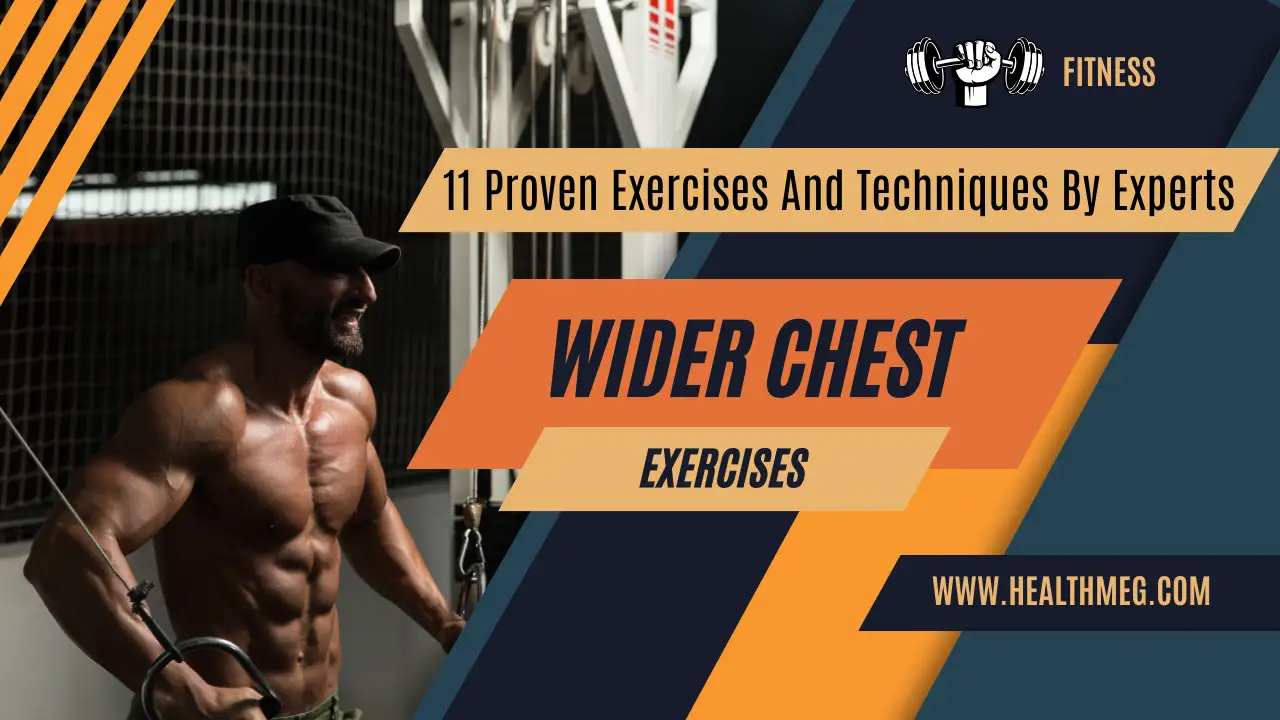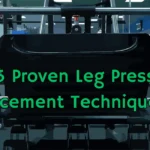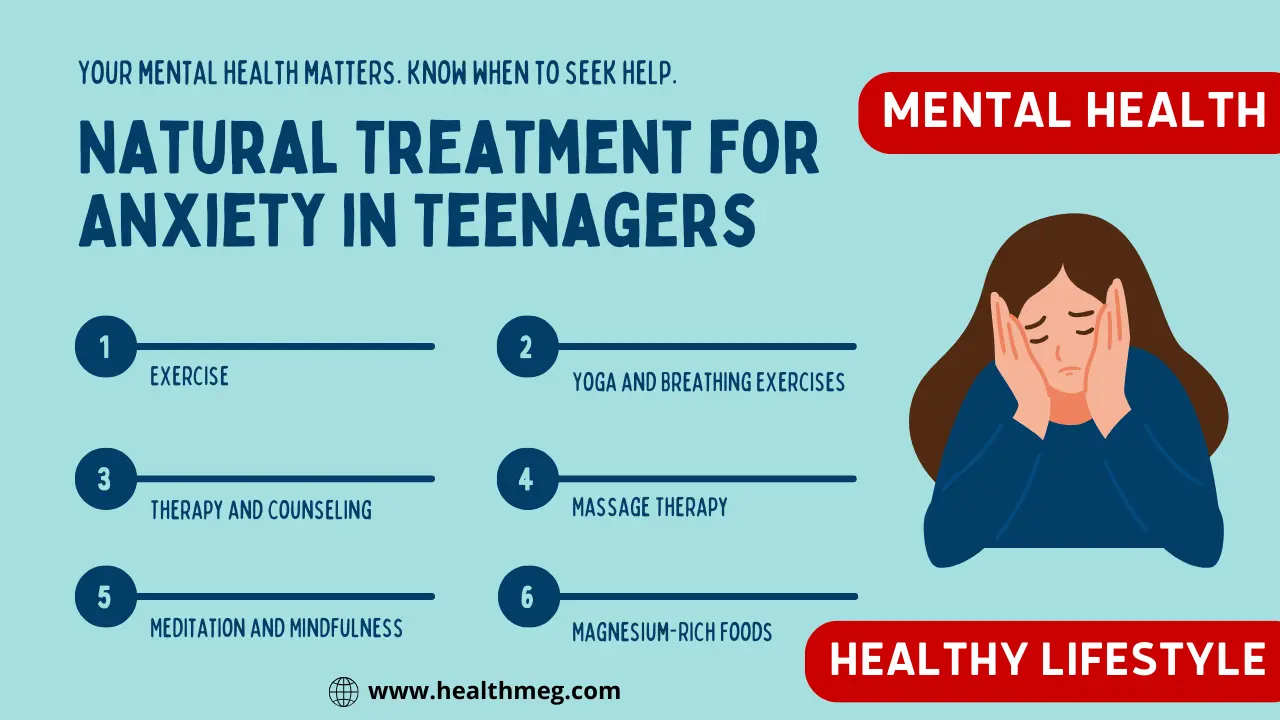Introduction
A wider, more muscular chest is a goal for many men looking to build an impressive physique. While genetics play a role in chest width, the right exercises and techniques can help maximize chest fitness development.
Having a wide, well-developed chest is one of the top goals for many men looking to build an impressive physique. Not only does a wider chest create a powerful masculine look, but it also helps improve strength and athletic performance.
However, knowing which exercises and techniques truly work to expand chest width can be confusing. There’s a lot of misleading or downright false information out there.
In this comprehensive guide, we’ll explain 11 of the most effective exercises and training methods for building a wider chest. With expert tips on form, repetition ranges, and workout programming, you’ll have all the tools needed to sculpt an eye-catching upper body.
Do read the People Also Ask (FAQs) about this topic.
Key Takeaway
| Summary |
|---|
| A wider chest improves aesthetics and creates a stronger, more muscular look. |
| Expanding chest width increases the cross-sectional area of the pecs, enhancing pushing strength. |
| A wider chest provides separation from the anterior delts for a fuller shape. |
| The bench press recruits multiple muscle fibres across the pecs for width growth. |
| The dumbbell fly works the pecs through a large ROM, great for width. |
| Wide grip push-ups target the difficult-to-reach outer pec fibres. |
| Cable crossovers target the lower and outer pecs for width. |
| Overhead presses build the front and side delts, enhancing the chest V-taper. |
| Train chest no more than 2x per week for proper recovery and growth. |
| Use a mix of barbell, dumbbell and isolation exercises at various angles. |
| Practice proper form – avoid excessive arching or shoulder strain. |
Why Train for a Wider Chest?
Before jumping into the exercises, it’s important to understand why having a wider chest is so desirable in the first place. Here are the main benefits:
- Enhanced Masculine Physique. A broad chest with well-developed pectoral muscles is a quintessential marker of a masculine, powerful frame. Wide pecs help create the classic “V-taper” look that makes your shoulders appear broader.
- Improved Strength. Expanding the width of your chest directly correlates to increased pressing power. Wider pecs allow you to recruit more muscle fibres when bench pressing or doing push-ups.
- Better Athletic Performance. Sports like football, wrestling, boxing, and martial arts require chest strength to overpower opponents. A wider chest helps optimize this force.
- Proportional Balance. Wide pecs provide an ideal counterbalance to wide lats and big biceps, creating a symmetrical upper body that looks strong from all angles.
- Enhanced Confidence. There’s no denying it, the look and power of a well-built chest elicit respect and self-assurance. It’s a legitimate health and social benefit.
Purposeful training for increased chest width delivers results that extend far beyond just appearance and vanity. It’s very much functional and performance-driven.
Now let’s learn exactly how to achieve it.
11 Wider Chest Exercises
- Regular Bench Press
- Dumbbell Fly
- Wide Grip Push-ups
- Low-to-High Cable Crossover
- Wide Grip Incline Bench Press
- Decline Push-ups
- Overhead Press
- Wide Grip Push-ups Plus Band
- Dumbbell Pullover
- Resistance Band Fly
- Parallel Bar Dip
1. Regular Bench Press
The classic bench press remains one of the most effective mass-builders for the entire chest. By recruiting multiple muscle fibres across the pectorals, it develops width through sheer muscle growth.
When doing the bench press for a wider chest:
- Use a wide grip on the bar to emphasize the outer pecs. Gripping the bar 1.5-2x shoulder-width apart is ideal.
- Control the descent and pause briefly at the bottom. This maximizes time under tension for full muscle recruitment.
- Focus on squeezing the pecs and driving the elbows outward as you press the weight. This enhances the contraction of the inner and outer fibres.
- Perform 4 sets of 6-10 reps as part of your workout to spur muscle growth.
The barbell bench allows you to use heavy weights for mass building. You can also use dumbbells or a Smith machine for variety.
2. Dumbbell Fly
The dumbbell fly works the pectorals through a large range of motion, making it excellent for expanding chest width.
To properly perform fly:
- Lie back on a bench holding dumbbells above your chest with arms extended. Palms can face inward or outward.
- Keeping a slight bend in the elbows, lower the weights out to your sides in an arc until a stretch is felt in the chest.
- Squeeze your pecs to bring the dumbbells back above your chest.
- Repeat for 3-4 sets of 10-12 controlled reps.
Focus on feeling the outer pecs contract at the top. Avoid swinging the weights and keep tension on the target muscles.
3. Wide Grip Push-ups
For developing chest width at home or on the go, wide-grip push-ups are hugely effective. The challenge of moving your entire body weight over a large range of motion provides great muscular stimulation.
To perform:
- Take a wide grip on the floor inside shoulder-width, hands rotated outward slightly.
- Keeping the body in a straight line, lower yourself until your chest nearly touches the ground.
- Press back up, squeezing the chest muscles together at the top.
- Aim for 3-4 sets of 12-15 reps. You can also do drop sets, lowering your hips toward the ground to make them harder.
Wide push-ups allow you to focus on expanding the pecs without equipment. Use these liberally for on-the-go chest training.
4. Low-to-High Cable Crossover
This cable exercise targets the lower and outer pectorals for maximum width. Here’s how it’s done:
- Attach a straight or rope handle to each side of a cable station. Stand between the cables with knees bent slightly.
- With arms crossed holding the handles, pull your hands down and across your body until fully stretched.
- Squeeze the pecs to bring your hands upward and inward until they come together above your head.
- Slowly reverse back to the starting position.
- Perform 3 sets of 12-15 reps, focusing on flexing the pecs at the top.
The crossover motion maximizes contraction of the lower and outer pec fibres for complete chest development.
5. Wide Grip Incline Bench Press
Incline pressing is ideal for targeting the upper chest. Combining this with a wide grip hits the upper pecs through a longer range of motion for great width gains.
- Set an adjustable bench to 30-45 degrees incline. Grip the bar about 1.5x shoulder-width with an exaggerated outward hand flare.
- Lower the bar slowly to your upper chest before pressing back up.
- 3-4 sets of 6-10 reps are recommended, focusing on squeezing the upper pecs at the top.
The angle makes the upper chest work harder. The wide grip expands stimulation to the outer pec fibres.
6. Decline Push-ups
Decline push-ups involve elevating your feet higher than your head to increase activation of the lower pecs. This is easy to do at home:
- Place your feet on a stable elevated surface like a bench, chair, or stair. Keep hands shoulder-width apart.
- Maintaining a straight line from head to heels, lower your upper body down toward the floor.
- Press yourself back up, squeezing the chest at the top.
- Aim for 3 sets of 10-12 reps. You can make these harder by elevating your feet higher or adding weight to your back.
Decline push-ups force the lower chest to work harder. Do these consistently to build width from bottom to top.
7. Overhead Press
While not a chest exercise, overhead pressing builds the front and side deltoids, creating “3D” width and separation between the shoulders and chest.
For mass building:
- Perform overhead presses standing or seated, with either a barbell or dumbbells.
- Lower the weights to your collarbone or right above, then press straight overhead with elbows pointing out slightly.
- Use 3-4 sets of 6-10 reps. Squeeze the delts and hold briefly at the top.
Developing rounded, well-defined shoulders enhances that dramatic V-taper and makes your chest appear wider by contrast.
8. Wide Grip Push-ups Plus Band
Resistance bands add challenge to push-ups. By combining them with a wide hand position, you can target the difficult-to-reach outer pec fibres.
To perform:
- Place both hands inside shoulder-width on the floor and loop a resistance band above your back.
- Keeping the core braced, lower into a push-up. As you press back up, pull your hands wider apart to activate the pecs.
- Do 3 sets of 10-12 reps with constant tension on the target muscles.
Band push-ups allow you to safely use forced reps and continuous tension principles for new growth. Experiment with different band strengths as needed.
9. Dumbbell Pullover
The dumbbell pullover predominantly works the lats and serratus. But incorporating a wide elbow flare also brings the outer chest into play:
- Lie perpendicular on a bench holding a single dumbbell with both hands.
- Keeping a slight bend in the elbows, lower the dumbbell back beyond your head in an arc.
- Bring the weight back above your chest, flaring the elbows out wide.
- Use lighter weights and higher reps – 2-3 sets of 15+ reps per set.
The combination of stretching the pecs and isolating the outer fibres makes pullovers a great finisher for chest-width training.
10. Resistance Band Fly
Band fly allows you to focus on squeezing and contracting the pecs through a full range of motion. To do them:
- Anchor the band above your head and grip each side handle near shoulder height.
- Initiate the movement by pressing your hands up slightly to create tension.
- With a slight bend in the elbows, stretch your arms out laterally until you feel a stretch in the chest.
- Squeeze your pecs to return to the start position.
- Perform 3 sets of 15-20 reps. Keep constant tension on the muscles.
Pick a band strength that lets you complete all reps with perfect form. Extend the stretch and contract the pecs hard for maximum width development.
11. Parallel Bar Dip
Dips heavily target the inner pecs, but using a wide hand placement also brings the outer chest into play:
- Mount parallel bars and place your hands as far out on the bars as you can without feeling strain on the shoulders.
- Keeping the elbows pointed backwards, lower your body until you feel a stretch in your chest and shoulders.
- Press back up, focusing on squeezing the pecs together at the top.
- Do 3-4 challenging sets of 6-10 reps. Weight can be added once bodyweight dips become easy.
The combination of heavy loading and increased range of motion makes dips a top choice for chest-width training.
How to Program for Safe, Effective Gains
To transform your chest safely and efficiently, here are some evidence-based programming guidelines:
- Train chest no more than 2x per week
- Use a mix of heavy and light loads: 1-5 reps for strength, 10-15+ reps for hypertrophy
- Vary incline, decline, and flat pressing for balanced development
- Progressively increase load, volume, and intensity over time
- Periodize training with 4-6 week mesocycles and targeted deloads
- Maintain proper form – never sacrifice range of motion or overload joints
Tracking workout metrics can help gauge progress and prevent overtraining. But don’t get caught up solely chasing numbers – focus on feeling the target muscles working through a safe, controlled range.
A sample chest workout could look like this:
Workout A
- Wide Grip Bench Press – 4 sets x 6, 8, 10, 12 reps
- Incline Dumbbell Flye – 3 sets x 10 reps
- Cable Crossover – 3 sets x 12 reps
- Wide Grip Push Up – 3 sets max reps
- Decline Dumbbell Press – 3 sets x 8-10 reps
- Chest Squeeze Finisher – 3 holds x 30 seconds
Workout B
- Decline Barbell Press – 4 sets x 5, 8, 10, 12 reps
- Neutral Grip DB Press – 3 sets x 8 reps
- Chest Dip – 3 sets x failure
- Band Chest Flye – 3 sets x 12 reps
- Svend Press – 3 sets x 8 reps
- Spread Eagle Push-Up – 3 sets max reps
Perform these workouts twice a week on non-consecutive days, like Monday and Thursday. That allows optimal frequency for maximum pec growth.
This covers the full spectrum of horizontal and vertical presses, flies, dips, push-ups, and finishers to pack slabs of muscle onto your chest.
By focusing only on the exercises definitively proven to expand pec width, you will build an incredibly impressive chest that pops from all angles.
Chest Width Exercise Technique Tips
Here are some important technique pointers for maximizing chest width development and preventing injury:
- Maintain retracted shoulders on pressing movements to reduce strain on the front delts.
- Limit the range of motion if any exercise causes discomfort in the shoulders or pecs.
- Keep elbows under wrists when doing flies to prevent excessive shoulder extension.
- Squeeze the pecs at the top of each rep and avoid rapid bouncing reps, which can strain the chest tendons.
- Maintain a steady tempo – don’t abruptly lock out elbows at the top.
- Keep the core braced to prevent excessive arching of the lower back which can cause injury.
- Avoid touching the bar to your chest when benching – stop 1-2 inches above for safer shoulder positioning.
Proper form should always take priority over chasing bigger weights or reps. Have a training partner watch your technique or film yourself to ensure quality execution.
Ideal Rep Range for Chest Width
One important question is the ideal rep range that provides maximum mechanical tension and muscle damage to expand chest width.
Based on my research, here are the best rep recommendations:
- Heavy Strength Sets: 2 to 5 reps. Use a 3 to 5RM weight to focus on building absolute power.
- Moderate Hypertrophy Sets: 8 to 12 reps. Allows moderate load with enough volume for size gains.
- Metabolic Pump Sets: 15 to 20 reps. Burn out pecs fully while enhancing blood flow between sets.
Aim to use a variety of rep ranges throughout a workout to stimulate all muscle fibre types. This provides complete, well-rounded chest development.
The key is progressively overloading the pecs within each rep range over time to force continued width gains.
Supplements To Support Chest Growth
While nutrition and training are most important, certain supplements can provide additional benefits:
Creatine
- Helps increase strength and lean mass gains
- 5 g/day appears effective; cycling not necessary
Protein Powder
- Provides protein around workouts for recovery
- Whey, casein, beef and soy varieties are effective
Omega-3s
- May reduce inflammation from training
- Contains EPA/DHA essential for health
- Oily fish or supplements can provide adequate intake
ZMA:
- Zinc, magnesium, and vitamin B6 may elevate testosterone and improve sleep quality.
Always look for quality products without unnecessary additives or fillers. Speak to your doctor before starting any new supplement, especially if you have any medical condition.
Nutrition Tips for Building Chest Size
Proper nutrition provides the raw materials for muscle growth and recovery. To support your chest training:
- Eat slightly above maintenance in a 300-500 calorie surplus to maximize mass gains.
- Consume at least 0.5-1 gram of protein per pound of body weight daily from high-quality sources like lean meats, eggs, and protein powder.
- Fill the rest of your calories from carbs and healthy fats while limiting junk foods, refined carbs, and saturated fats.
- Have a fast-digesting protein shake before and after workouts to supply muscles with amino acids when they need them most.
- Time the majority of your carbohydrate intake around your workouts for energy and growth.
- Stay well hydrated before, during, and after training.
If struggling to gain mass, gradually increase total calories while monitoring weight and body composition changes. Get bloodwork done if you hit plateaus to identify any deficiencies impeding progress.
Sample High Protein Chest Building Meals
Here are a few sample meal options to support chest growth:
Breakfast: Oatmeal, whey protein, banana, mixed nuts
Lunch: Chicken breast, brown rice, veggies
Dinner: Steak, sweet potato, spinach salad
Snacks: Greek yogurt, protein bar, hardboiled eggs
Pre-workout: Whey and creatine protein shake, banana
Post-workout: Whey, creatine, dextrose powder
Focus on getting at least 25-35 grams of protein every 3-4 hours from clean sources along with complex carbs and healthy fats. This provides your muscles with a steady supply of amino acids to promote growth.
Chest Width Training Mistakes To Avoid
Here are some common mistakes that can sabotage your gains:
- Warm up thoroughly and start with lighter sets to prep muscles
- Warm up thoroughly and start with lighter sets to prep muscles
- Avoid over-arching the lower back or flaring elbows excessively
- Never train through sharp or prolonged pain – see a physical therapist
- Monitor body symmetry and avoid muscle imbalances
- Manage recovery with sleep, massage, and active rest between intense sessions
- Overtraining chest muscles without allowing for adequate recovery between workouts.
- Using poor form, especially excessive arching, shoulder impingement, or partial reps.
- Bouncing the weights or using momentum rather than controlled reps.
- Routinely lifting too heavy at the expense of form and injury risk.
- Neglecting the upper and lower chest which limits full muscle development.
- Not changing up your exercise selection and rep ranges periodically.
- Insufficient calories/protein for muscle growth needs.
- Poor mind-muscle connection and focus during workouts.
Learn proper form, focus on quality over quantity, change up your program regularly, and allow enough recovery to spur growth. This will help you build an impressive wider chest safely over time.
Conclusion
Achieving a wider chest requires diligent training using presses, flies, and dips performed through a large range of motion targeting all areas of the pectorals. Combine multi-joint and isolation exercises at various angles while practising proper form and providing your body with the nutrition it needs.
Be patient and trust the process. Muscle gains take months of hard work. But with a well-designed training and nutrition program incorporating these effective exercises, you can transform your physique.
So use this guide to start building a thicker, wider chest that looks powerful from the front and side. With dedication to your workouts and recovery, your chest will become a muscular showpiece and contribute to that coveted V-taper.
People Also Ask (FAQs)
Q) How do I make my chest wider?
A) Some effective ways to make your chest wider include:
- Performing pressing movements like bench presses and pushups with a wide grip. This emphasizes the outer pecs.
- Incorporating flye exercises like dumbbell flyes. The stretched position targets the inner and outer pec fibres.
- Doing cable crossovers focusing on squeezing the lower and outer pecs.
- Adding overhead shoulder pressing to build the front and side delts, enhancing the chest V-taper.
- Training at incline, decline and flat angles to hit the chest from top to bottom.
- Allowing proper recovery between chest workouts for muscular growth.
Q) Can I increase my chest width?
A) Yes, it is possible to increase chest width through targeted training, but genetics play a limiting role. Performing presses flies and dips through a large range of motion with a focus on the outer pecs can maximize your genetic potential over time.
Q) What exercise makes your chest look bigger?
A) The bench press is arguably the most effective for overall chest development. But flye variations like dumbbell and cable flyes train the inner and outer pecs through an extended range to increase width. Pushups and dips are also excellent. A combination of multi-joint and isolation moves works best.
Q) How can I increase my chest expansion?
A) Focus on exercises that provide a deep stretch of the pectorals like flies and crossovers. Emphasize the outer pecs with wide grip presses and pushups. Work the upper and lower pecs through incline, decline and standard presses. Build the front delts with overhead presses for a wider look.
Q) Why is my chest not wide?
A) Genetics plays a big role in chest width, so you may lack the natural structure for width. Or you may be training with too narrow a hand position on presses. Not working the upper and lower pecs equally can also limit full-width development. Assessing your training style and form is key.
Q) Why my chest is not growing?
A) Suboptimal training volume, lack of progressive overload, inadequate protein intake, and poor recovery habits can all limit chest growth. Analyze your training splits, exercise selection, nutrition, and recovery to identify potential weak points.
Q) Is a broad chest attractive?
A) Research shows that women on average find a broad, well-developed chest more attractive than men. A wider chest contributes to a stronger, more muscular appearance of the upper body. But it should be developed through proper training and nutrition, not artificial means.
Q) Is chest width genetic?
A) Genetics plays a very large role in determining someone’s natural chest width and shape. The structure of your rib cage and shoulder joints limits how much width can develop through training alone. However, focused work can help maximize your genetic potential.
Q) How big is a 40-inch chest?
A) A 40-inch chest measurement is considered quite broad and well-developed. For perspective, the average American male chest size is around 42 inches. Bodybuilders and athletes with focused chest training can achieve measurements between 40-50 inches.
Q) Can you change your chest shape?
A) It is challenging to fully change your natural chest shape due to skeletal structure. However, focused training can enhance size in certain areas to improve the appearance of width and fullness from the front and side. Genetics remain the overarching factor.
Q) How long does it take to widen your chest?
A) Building noticeable width in a trained chest generally takes consistent work over several months to years. 2-3 months of focused training may produce initial measurable gains, but the progression extends over longer timeframes. Genetics accelerate or hinder the process. Patience and persistence are key.












